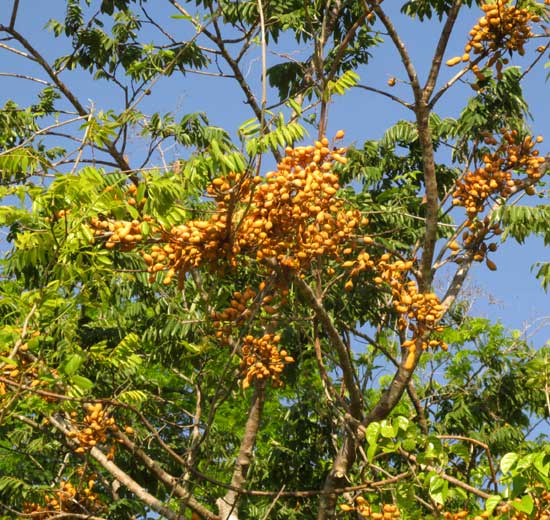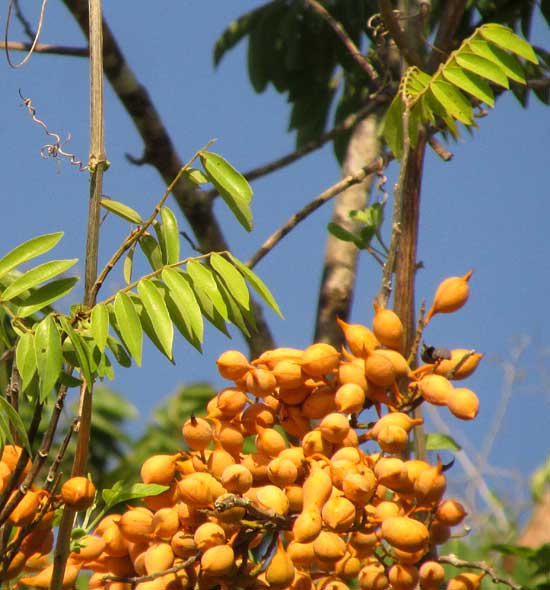Excerpts from Jim Conrad's
Naturalist Newsletter
from the May 24, 2018 Newsletter issued from Rancho Regenesis in the woods ±4kms west of Ek Balam Ruins; elevation ~40m (~130 ft), N~20.876°, W~88.170°; central Yucatán, MÉXICO
MEXICAN EBONY FRUITING
Three Sundays ago as I biked toward the frutería in Temozón, just three or so kilometers north of town, I was astounded to see two large trees along the road very conspicuously bearing large crops of golden-yellow fruits. Below, you can see part of a branch of one tree:

I was astonished because, traveling this same route almost every Sunday for a year and a half, how could I have missed those trees until now? Why hadn't I noticed the fruits the previous week, or this time one year ago? I'd never seen anything like this. The trees, entangled among many other trees, bushes and vines, were hard to get to, and the fruits were rather high up, so the best fruit picture my camera's modest telephoto lens could provide is shown below:

The leaves arise alternately on the stems, and are pinnately compound, almost like those of the north's walnut trees. The fruits are unusual not only for their abundance, but also each fruit bears a kind of nipple at its end, and at its base narrows into a kind of stem. Most of this tree's fruit bodies are ±spherical, but some fruits display two bulging parts, looking like peanut shells.
My Maya friend at the frutería in Temozón looked at the above pictures on my camera's display screen and said he'd seen this tree before. It's not planted but rather grows in the wild, where it's uncommon and not much good for anything other than that birds eat its fruits.
My delay in introducing you to this tree is because it took several sessions on the Internet during my visits to Ek Balam to identify it. At first even its plant family was unclear. But then in the above photo I noticed that the fruit pods show sutures along their sides, where at maturity they split open to release their seeds. My friend said the seeds were beanlike, and in the Bean Family many species bear pinnately compound leaves like these, so I began looking in the Bean Family, which is so huge that it took a while.
The tree is indeed in the Bean Family. It's SWARTZIA CUBENSIS, in English known as Mexican Ebony, Mexican Royal Ebony, and by an indigenous name of Katalox. It's native to southern Mexico, Central America and northern South America. Judging from the literature, it's uncommon or rare, or even very rare, in this area. In rainier climes the tree can reach 100-130ft tall (30-40m) but ours, though rising above trees around them, grew less than half that tall.
Despite my friend's claim that just birds like it, one reason Mexican Ebony may be rare here is that it's internationally famous for its hard, strong, blackish wood. True Ebony trees, members of the Ebony or Persimmon Family, are being overharvested everywhere and are disappearing fast because of their high market value. Mexican Ebony is gaining fame as a substitute for true Ebony, and now it's growing rare, too. On the Internet, searching on the keywords of "Katalox Mexican Ebony" you can find many companies selling its timber, and marketing products made from the wood. During my brief survey I found a company constructing guitars from the wood, and another selling handmade kitchen utensils -- very dark, expensive wooden spoons, spatulas, butter-smearing knives, etc.
from the June 14, 2018 Newsletter issued from Rancho Regenesis in the woods ±4kms west of Ek Balam Ruins; elevation ~40m (~130 ft), N~20.876°, W~88.170°; central Yucatán, MÉXICO
MEXICAN EBONY BEAN PRODUCTION
Since the above entry was made in mid May, each Sunday on my bike trip to Temozón to buy fruit I've been checking on the same tree, hoping to catch the moment when its legumes split to release their beans. On June 3rd, the first pods were splitting, and I got to see at least one one bean, which was bright red, and seemingly covered with a soft flesh. Because the tree was inaccessible, I could only examine it via pictures taken with my modest telephoto lens. below, you can see the red bean of June 3rd, apparently having been pecked at by hungry birds:

In that image you can see that a few pods already have expelled their beans, and turned black. I think the reason that on June 3rd I could see only one bean among hundreds of pods is that birds relished eating the beans as soon as they appeared. In fact, on June 3rd the tree was swarming with birds, mainly chachalacas, Black-throated Saltators and Altamira Orioles. I made many efforts to photograph a bird eating the bean, but the birds so nervously flitted about that they were too fast for me to focus on them. They were nervous not because of my presence, but because they were competing with other birds for a very few beans.
During my visit to the tree last Sunday, June 20th, I thought I'd see many more beans, and an even greater number of hungry birds. What I saw is shown below:

During seven days all the legumes had lost their seeds, leaving only a few black, dried-out husks on the tree, and not a bird was present.